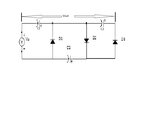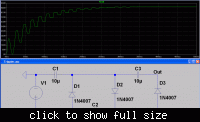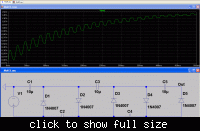Shayaan_Mustafa
Full Member level 5

Hello experts!
Here is a voltage tripler circuit attached. I want to know the working of this circuit. Assume the circuit is grounded and diodes are ideal i.e. they will not drop any voltage across them typically 0.7v.
STEPS:
1) When a -ve cycle comes, D1 activates and C1 charges to peak voltage(Vp) ideally. While other diodes remain off and no other capacitors will charge.
2) When a +ve cycle comes, D2 is activated and as C1 is already charge, (C1 discharges in this step through D2), so source peak voltage and C1 voltage charge C2 to 2Vp.
3) When again -ve cycle comes, D1 activates and C1 charges to Vp. As C2 is already charged then it will activate D3 and allows C3 to charge upto the voltages that were hold by C2 i.e. 2Vp.
FINAL:
Output will be taken across C1(Vp) and C3(2Vp). Hence, we get 3Vp
Is this all working correct? Help me so that i could design a voltage multiplier that gives 5 times output of voltage source.
Thanks.**broken link removed**
Here is a voltage tripler circuit attached. I want to know the working of this circuit. Assume the circuit is grounded and diodes are ideal i.e. they will not drop any voltage across them typically 0.7v.
STEPS:
1) When a -ve cycle comes, D1 activates and C1 charges to peak voltage(Vp) ideally. While other diodes remain off and no other capacitors will charge.
2) When a +ve cycle comes, D2 is activated and as C1 is already charge, (C1 discharges in this step through D2), so source peak voltage and C1 voltage charge C2 to 2Vp.
3) When again -ve cycle comes, D1 activates and C1 charges to Vp. As C2 is already charged then it will activate D3 and allows C3 to charge upto the voltages that were hold by C2 i.e. 2Vp.
FINAL:
Output will be taken across C1(Vp) and C3(2Vp). Hence, we get 3Vp
Is this all working correct? Help me so that i could design a voltage multiplier that gives 5 times output of voltage source.
Thanks.**broken link removed**




